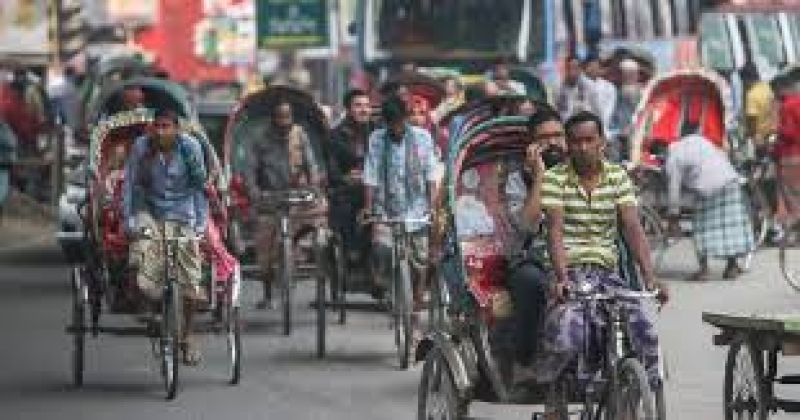- Body of Osman Hadi Returns to Dhaka From Singapore Late |
- Fakhrul condemns attacks on media, calls for unity, justice |
- 2 cops among 4 hurt in clash outside Indian Assit H.C. in Ctg |
- Inqilab Moncho urges people to avoid violence |
- Hadi’s death: Prothom Alo, Daily Star offices set afire |
Rickshaws and life in Dhaka City

Richshaws in Dhaka City
Dhaka, May 12 — The soft jingle of rickshaw bells weaving through the bustling alleys and traffic-choked arteries of Dhaka has long been a signature sound of the city’s heartbeat.
From dawn to the deep hours of night, these humble three-wheelers — both pedal-powered and battery-run — remain an inseparable thread in the capital’s urban fabric.
Yet, as the megacity steadily advances towards modernity, the continued presence of these iconic vehicles has sparked fervent debate.
At the heart of the discourse lies a pressing question: Can Dhaka ever become truly rickshaw-free?
A Choking Gridlock
Although precise figures remain elusive due to the absence of a comprehensive survey, urban experts estimate that nearly one million rickshaws ply the streets of Dhaka daily.
Of these, alarmingly, only around 80,000 are formally registered with Dhaka North and Dhaka South City Corporations.
The remainder operate informally, contributing to a chaotic and often unregulated streetscape.
Their overwhelming numbers significantly impede the city’s traffic flow. Average vehicle speeds on main roads often dwindle to a sluggish 6–7 kilometres per hour. This inefficiency transcends mere inconvenience.
A 2018 World Bank report starkly quantified the cost of congestion, estimating annual economic losses of $3–5 billion for the city.
Human Cost and Social Ties
Yet, while rickshaws may bear the brunt of blame for traffic snarls and lost productivity, they also represent a crucial lifeline for millions.
An estimated 2.5 to 3 million people directly rely on rickshaws for their livelihood — a sprawling ecosystem comprising drivers, garage owners, mechanics and manufacturers.
For countless residents, particularly those from lower- and middle-income brackets, rickshaws remain the most affordable and accessible means of daily transport — especially in underserved areas where buses and mass transit fail to reach.
Governmental Hesitation and Public Pushback
In 2019, the Dhaka South City Corporation sought to impose a ban on rickshaws along several key corridors — including Gabtoli-Azimpur, Science Lab-Shahbagh and Kuril-Banani.
But the plan, introduced without viable alternatives, was swiftly met with public uproar and soon abandoned.
“Completely banning rickshaws is detached from reality,” an urban planner told UNB. “What we need is a planned, zone-based regulation system. Rickshaws should be allowed where they are suitable, such as narrow streets and lanes.”
Rise of Battery Rickshaws and Call for Policy Reform
Ashis Kumar Dey, General Secretary of the National Committee to Protect Shipping, Roads and Railways, voiced concerns over the proliferation of battery-operated rickshaws, which he described as chaotic and dangerously prone to accidents.
He, however, acknowledged the irreplaceable role these vehicles play.
“The movement of these small three-wheeled vehicles across Dhaka has created employment for 2.5 to 3 million people. About 6 million more depend on their income. So, there is no scope for stopping these vehicles,” he said.
He called for a dedicated policy under local government control, encompassing everything from infrastructure development to the licensing, registration and training of drivers. Notably, Bangladesh University of Engineering and Technology (Buet ) has already developed a pilot model of battery-rickshaw infrastructure, which it has submitted to Dhaka North City Corporation for review.
“If the government approves it, positive results will come,” he added.
Unchecked Growth and Need for Control
Saidur Rahman, Executive Director of the Road Safety Foundation, acknowledged rickshaws’ enduring importance but cautioned against their unchecked proliferation.
“There is no doubt that rickshaws are an essential mode of transport for residents of the capital. However, the number must be determined based on road capacity,” he said.
According to him, the rampant rise of battery-operated rickshaws has paralysed the city with congestion. "Alongside this, accidents are rising. People from across the country are flocking to Dhaka to operate auto-rickshaws. Controlling or stopping this influx has become a major challenge for the government.”
He advocated for sustainable, phased interventions, “To keep the capital at least somewhat functional, we must regulate auto-rickshaws through short-, medium-, and long-term plans. These include banning the import of components, improving vehicle safety, and enforcing strict registration.”
Rahman’s broader recommendations extended to economic decentralisation and youth development: mandatory licensing for drivers, establishment of industrial zones outside the capital, structured market systems for agriculture, and overseas employment opportunities for the educated youth.
“Such steps will not only curb the unchecked dominance of auto-rickshaws but also bolster the national economy,” he asserted.
A City of Megaprojects, But Few Alternatives
While ambitious projects like the metro rail and Bus Rapid Transit (BRT) promise transformative change, their full-scale functionality remains a distant dream. In their absence, the lack of last-mile connectivity continues to tether residents to the modest rickshaw — a vehicle as nimble as it is essential.
Even efforts like bus route rationalisation have stalled, mired in delays and resistance. As a result, rickshaws persist as a vital, if imperfect, link in Dhaka’s transport chain.
A senior officer from the Dhaka Metropolitan Police's Traffic Division, speaking to UNB on condition of anonymity, offered a pragmatic view, “If every rickshaw is brought under digital registration, drivers are trained, and a route-based regulation is enforced — they can remain an essential part of Dhaka’s transit system.”
As Dhaka gallops towards modernity, the notion of a rickshaw-free city remains, for now, a distant utopia. These ubiquitous three-wheelers, while seen by some as the root of the city’s woes, are deeply woven into its socio-economic and cultural fabric.
Instead of ostracising them as obstacles, perhaps it is time policymakers recognised their potential as part of the solution — crafting a future where progress and tradition can glide forward, side by side. - UNB

